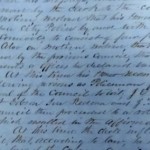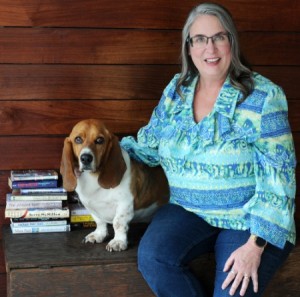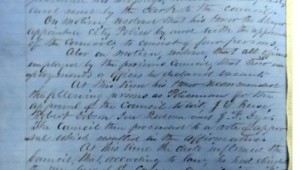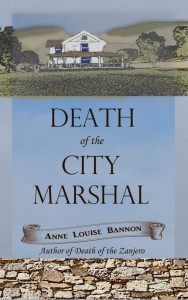
Historical mystery author Anne Louise Bannon reveals why L.A.P.D. personnel aren’t really sure how old the department is.
###
 Relevant History welcomes back historical mystery author Anne Louise Bannon, who writes the “Old Los Angeles” mystery series set in the 1870s and featuring Maddie Wilcox, and the “Freddie and Kathy Roaring ‘20s” series featuring Freddie Little and Kathy Briscow. Her most recent title is Death of the City Marshal. She and her husband live in Southern California with an assortment of critters. To learn more about Anne and her books, visit her web site and blog, and follow her on Facebook and Twitter.
Relevant History welcomes back historical mystery author Anne Louise Bannon, who writes the “Old Los Angeles” mystery series set in the 1870s and featuring Maddie Wilcox, and the “Freddie and Kathy Roaring ‘20s” series featuring Freddie Little and Kathy Briscow. Her most recent title is Death of the City Marshal. She and her husband live in Southern California with an assortment of critters. To learn more about Anne and her books, visit her web site and blog, and follow her on Facebook and Twitter.
*****
One of the most fun things about diving into the Research Rabbit Hole is that you never know what you’re going to find. Or not find.
For example, the founding of the Los Angeles Police Department. You’d think that it would be pretty straight-forward to identify the actual date of the department’s founding. The L.A.P.D. Museum cites 10 March 1869 as the date. The problem is there are no city council minutes with that date. There are minutes from 1 March 1869, which do not mention the police at all. There are minutes from 15 March 1869, which mention disciplining a couple police officers for “cruelty to a squaw.”
Even more interesting, there was a police committee dating back to 1855, and there is also a council minutes record from roughly the same time, designating the City Marshal as police chief, in addition to his other duties (which included collecting city taxes).
Even L.A.P.D. historians don’t seem to know where that 10 March date comes from. I know because they were emailing my husband to find out, and my husband forwarded the email to me for the fun of it.
Let me explain how my husband, Michael Holland, happens to be part of this. He’s the archivist for the City of Los Angeles. We never intended that he would become my personal research assistant, but, dang, it’s convenient. It was kind of his fault that happened. You see, his lecture on L.A.’s Zanja system (which was how they irrigated the city’s farms and vineyards before Mulholland raped the Owens Valley) got me started on my Old Los Angeles series, which I set in the 1870s for a lot of reasons I won’t go into here.
When is the real anniversary?
What this all boils down to is that the L.A.P.D. is celebrating the 150th anniversary of its founding this year—and we don’t really know when it was or what they’re counting from. There were police in L.A. before 1868, but we have reason to believe that they were volunteers. And we have a record in the City Council minutes from 21 December 1868 in which the mayor was to appoint “a City Police” made up of four men who would be employed by the city. So, my personal guess is that the mayor took his sweet time doing the official appointing and that whatever paperwork, if any there was, did not end up in the city records.
One of the men that the mayor recommended to be appointed as an officer, J.F. Dye, would play a part in a drama almost two years later that would result in the first officer killed in the line of duty. That victim was also the first person to be chief of the paid force, City Marshal William Warren. One thing that does make this so confusing is that the terms “Police Chief” and “City Marshal” appear interchangeably in the council minutes from 1855 on. This event became the basis for the second mystery in my “Old Los Angeles series,” Death of the City Marshal.
A rough place
Los Angeles was a pretty rough place from the 1850s on. The pueblo was founded in 1781, while California was still part of Mexico and under Spanish rule. When Mexico finally gained independence from Spain in 1821, it still controlled Alta California. Americans started arriving in the late 1840s and by 1848 had gained control of the state via the Treaty of Guadalupe Hidalgo.
In 1849, gold was discovered up north, and that brought even more Americans to Los Angeles. These were mostly failed miners and other transients, resulting in a lot of violence, mostly bar fights. By the late 1860s and into 1870s, it was still very violent, but families were moving in, and that meant things were starting to calm down, alas, not by much.
 By the fall of 1870, the police force had been expanded to six men. No surprise, the single most common petition made to the Common Council (as it was known at the time) was to request more police officers. The population had grown to around 5,700, still mostly men. Murders were down, but not by much, and one of the guys doing a fair amount of the killing was none other than City Marshal Warren. The other guy was probably Deputy Joseph Dye.
By the fall of 1870, the police force had been expanded to six men. No surprise, the single most common petition made to the Common Council (as it was known at the time) was to request more police officers. The population had grown to around 5,700, still mostly men. Murders were down, but not by much, and one of the guys doing a fair amount of the killing was none other than City Marshal Warren. The other guy was probably Deputy Joseph Dye.
Warren and Dye had started out as friends. Warren needed someone especially tough to patrol the worst parts of town. The problem was that both were hotheads, prone to shooting first and asking questions later. They had a falling out and, on 31 October 1870, got into a gunfight over who had the rights to the bounty on a prostitute.
I did massage the history a little in Death of the City Marshal. In the novel, Warren does not die of the wounds sustained in the gunfight, although in real life, he did. You can’t really have a whodunit if you know whodunit. We know what really happened because the court records are a lot more complete, and there were a lot of witnesses to the affray, which was thoroughly covered in the newspapers of the day.
I’ll be diving into the Research Rabbit Hole again soon. It’s always so much fun to see what I can find. But sometimes, it’s what I don’t find that makes things fun.
*****
 A big thanks to Anne Louise Bannon! She’ll give away an ebook copy of Death of the City Marshal to someone who contributes a comment on my blog this week. I’ll choose the winner from among those who comment by Friday at 6 p.m. ET. Delivery is available worldwide.
A big thanks to Anne Louise Bannon! She’ll give away an ebook copy of Death of the City Marshal to someone who contributes a comment on my blog this week. I’ll choose the winner from among those who comment by Friday at 6 p.m. ET. Delivery is available worldwide.
**********
Did you like what you read? Learn about downloads, discounts, and special offers from Relevant History authors and Suzanne Adair. Join Suzanne Adair’s Patreon, and subscribe to her free newsletter.
